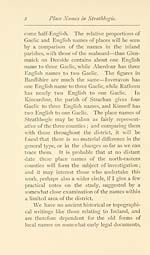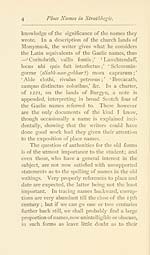Blair Collection > Place names in Strathbogie, with notes historical, antiquarian and descriptive
(23)
Download files
Complete book:
Individual page:
Thumbnail gallery: Grid view | List view

On the Study of Gaelic Place Xanies. 3
which have preserved the current pronunciation
of their own time, or of the time wlien the names
were first committed to writing. I am disposed
to think that this evidence, so far as relates to
Gaehc names, is occasionally undervalued — our
older writings being supposed to give us merely
the traditional sound of a language, which, ex-
cept in the Highlands, had become extinct by
the middle of the 14th century, and which was
unknown to the scribes, who often wrote care-
lessly and according to corrupt popular usage.
Gaelic dies slowly even in our own day, and we
have no clear evidence that it gave place to
English at such an early date. In these inland
districts, and off the main thoroughfares of the
country, it may have lingered to a much later
period than is generally supposed. I know, that
within fifty years, there were old families, natives
of the Lordship of Huntly, who had inherited
the knowledge, and continued the use of the
old language. A few Gaelic-speaking families
in a district would, no doubt, greatly conserve
the true sound of local names. As to the scribes
— they were the most literate class of their times ;
and probably not a few of those connected with
our northern religious houses, who have given
us our earlier documents, were of Celtic des-
cent, and knew Gaelic as their mother tongue.
Even so late as the i6th century, we have evid-
ence that some of them understood, or had some
which have preserved the current pronunciation
of their own time, or of the time wlien the names
were first committed to writing. I am disposed
to think that this evidence, so far as relates to
Gaehc names, is occasionally undervalued — our
older writings being supposed to give us merely
the traditional sound of a language, which, ex-
cept in the Highlands, had become extinct by
the middle of the 14th century, and which was
unknown to the scribes, who often wrote care-
lessly and according to corrupt popular usage.
Gaelic dies slowly even in our own day, and we
have no clear evidence that it gave place to
English at such an early date. In these inland
districts, and off the main thoroughfares of the
country, it may have lingered to a much later
period than is generally supposed. I know, that
within fifty years, there were old families, natives
of the Lordship of Huntly, who had inherited
the knowledge, and continued the use of the
old language. A few Gaelic-speaking families
in a district would, no doubt, greatly conserve
the true sound of local names. As to the scribes
— they were the most literate class of their times ;
and probably not a few of those connected with
our northern religious houses, who have given
us our earlier documents, were of Celtic des-
cent, and knew Gaelic as their mother tongue.
Even so late as the i6th century, we have evid-
ence that some of them understood, or had some
Set display mode to: Large image | Transcription
Images and transcriptions on this page, including medium image downloads, may be used under the Creative Commons Attribution 4.0 International Licence unless otherwise stated. ![]()
| Early Gaelic Book Collections > Blair Collection > Place names in Strathbogie, with notes historical, antiquarian and descriptive > (23) |
|---|
| Permanent URL | https://digital.nls.uk/81166622 |
|---|
| Description | A selection of books from a collection of more than 500 titles, mostly on religious and literary topics. Also includes some material dealing with other Celtic languages and societies. Collection created towards the end of the 19th century by Lady Evelyn Stewart Murray. |
|---|
| Description | Selected items from five 'Special and Named Printed Collections'. Includes books in Gaelic and other Celtic languages, works about the Gaels, their languages, literature, culture and history. |
|---|

